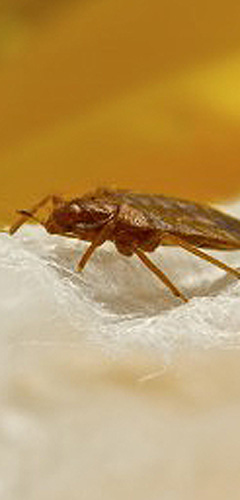- PEST PROBLEMS? CALL US NOW!
- 01865 362053 / 07802 485384
PEST CONTROL FOR Bed Bugs
(climex lectularis)
 Bed bugs often feed just before dawn while the host is asleep leaving bite marks most commonly found on the arms, legs and face. Bed bug control & removal can be tricky, in most circumstances a special industry regulated spray is used to effectively kill and remove bed bugs.
Bed bugs often feed just before dawn while the host is asleep leaving bite marks most commonly found on the arms, legs and face. Bed bug control & removal can be tricky, in most circumstances a special industry regulated spray is used to effectively kill and remove bed bugs.
Our team are often asked how to remove or kill bed bugs. As professional pest controllers we have access to special equipment and are qualified to use an industry approved spray for bed bug removal. Hawthorn can deal with bed bug infestations in both domestic and commercial environments such as hotels and boarding houses.
Adult bed bugs are around 4-5 mm long and 1.5 to 3 mm wide. They are reddish-brown in colour and oval, ‘flattened’ insects in shape. The size of the bed bug can vary depending on weather it has fed. Bed bugs cannot fly which means they can only crawl. However, they do rely on being carried on luggage and furniture which in many cases is the core reason for new bed bug infestations, especially in the domestic environment. The eggs of bed bugs are white, oval, about 1mm long and covered in a sticky film which enables them to adhere to surfaces.
Bed bugs feed on human blood and are most commonly found in sleeping areas, such as behind and underneath beds, underneath and around the seams of mattresses, behind furniture and pictures on walls and in furniture. Bed bugs have also been found in fittings and even in crevices in wallpaper. Bed bugs feed whilst the host is asleep, usually just before dawn, and leave bite marks which are commonly found on the face, arms and legs. However, bed bugs have also been known to bite other areas of the body as well. Bed bugs inject saliva as they feed and allergic reaction to this substance often causes slightly delayed swelling, itching and burning. In many cases, brown specks are often seen on bed linen, where drops of blood left after feeding have dried.
Female bed bugs can lay between 200 and 500 eggs and at a temperature above 21C these hatch into nymphs in 6 to 17 days. The appearance of juvenile bed bugs is very similar to that of the adult bed bug, although they are smaller and lighter in colour. As the juvenile bed bugs grow they become larger and darker. The ability for a bed bug to grow depends on the frequency of their ability to have a blood feed and the temperature of the environment surrounding them. Adult bed bugs can survive up to 2 months without food, but under certain circumstances can live a year or more without food.
Bedbugs are traditionally associated with conditions of poor hygiene. However, this does not mean that clean homes are immune from infestation, nor does it mean that an infestation must mean that a house is not clean. However, bed bugs do find it easier to spread faster in conditions of poor hygiene, which means that infestations become larger and more challenging to treat. Hawthorn Pest Control has experience of the treatment of bed bugs in domestic and commercial environments.

